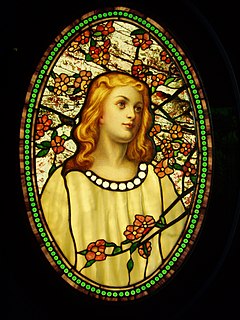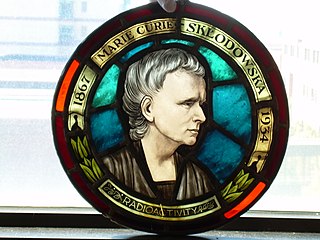
Sir William Blake Richmond KCB,, PPRBSA was a British painter, sculptor and a designer of stained glass and mosaic. He is best known for his portrait work and decorative mosaics in St Paul's Cathedral in London.

Guido Nincheri was a Canadian painter and designer working mainly in stained glass and fresco.

Franz Mayer of Munich is a German stained glass design and manufacturing company, based in Munich, Germany and major exponent of the Munich style of stained glass, that has been active throughout most of the world for over 170 years. The firm was very popular during the late nineteenth and early twentieth century, and was the principal provider of stained glass to the large Roman Catholic churches that were constructed throughout the world during that period. Franz Mayer of Munich were stained glass artists to the Holy See and consequently were popular with Roman Catholic clients. The family business is nowadays managed in the fifth generation and works in conjunction with renowned artists around the world.

St. Peter's Cathedral Basilica, is a church located at 196 Dufferin Avenue in London, Ontario, Canada for the seat of the Roman Catholic Diocese of London.

Clayton and Bell was one of the most prolific and proficient British workshops of stained-glass windows during the latter half of the 19th century and early 20th century. The partners were John Richard Clayton (1827–1913) and Alfred Bell (1832–1895). The company was founded in 1855 and continued until 1993. Their windows are found throughout the United Kingdom, in the United States, Canada, Australia and New Zealand.

Tiffany glass refers to the many and varied types of glass developed and produced from 1878 to 1933 at the Tiffany Studios in New York, by Louis Comfort Tiffany and a team of other designers, including Clara Driscoll, Agnes F. Northrop, and Frederick Wilson.

Saint Adalbert Basilica, is a historic Roman Catholic church located on Buffalo, New York's East Side within the Diocese of Buffalo. It is a prime example of the Polish Cathedral style of church architecture in both its opulence and grand scale. A rare and special designation bestowed on the parish occurred in 1907, when the Vatican proclaimed St. Adalbert a basilica, the first in the USA. The proclamation, as well as its English translation, can be viewed to this day in the basilica's museum room.

Saint Stanislaus Kostka Catholic Church is a historic Polish church of the Roman Catholic Archdiocese of Chicago that is located at 1351 West Evergreen Avenue in the Pulaski Park neighborhood of Chicago, Illinois, United States. It is designated as the Sanctuary of Divine Mercy of the Archdiocese.

Holy Trinity Church is a historic church of the Roman Catholic Archdiocese of Chicago located at 1118 North Noble Street. It is a prime example of the so-called 'Polish Cathedral style' of churches, in both its opulence and grand scale. Along with such monumental religious edifices as St. Mary of the Angels, St. Hedwig's or St. John Cantius, it is one of the many Polish churches that dominate over the Kennedy Expressway in the Pulaski Park neighborhood of Chicago, Illinois.

St. Michael is a church of the Roman Catholic Archdiocese of Chicago. The current church is located at E. 83rd Street and S. South Shore Drive in South Chicago, a neighborhood of Chicago, Illinois.

The Marie Skłodowska-Curie Medallion is one panel from a set of four created by Jozef C. Mazur. It honors Marie Curie and currently resides in the Polish Room at the University at Buffalo Libraries.

St. Stanislaus - Bishop & Martyr Church is located at 123 Townsend Street, Buffalo, New York on the city's east side. The Church is the oldest Polish church in the Roman Catholic Diocese of Buffalo and holds the title of "Mother Church of Polonia" for western New York.

The Saint Gregory the Illuminator Cathedral, also known as the Yerevan Cathedral is the largest cathedral of the Armenian Apostolic Church. It is located in the Kentron District of Yerevan, the capital of Armenia, and is one of the largest religious buildings in the South Caucasus along with the Holy Trinity Cathedral of Tbilisi. Adjacent to the General Andranik metro station, it is visible from many areas of Yerevan.

William Willet was an American portrait painter, muralist, stained glass designer, studio owner and writer. An early proponent of the Gothic Revival and active in the "Early School" of American stained glass, he founded the Willet Stained Glass and Decorating Company, a stained glass studio, with his wife and partner Anne Lee Willet, in protest against the opalescent pictorial windows which were the rage at the turn of the twentieth century.

Nicola D'Ascenzo was an Italian-born American stained glass designer, painter and instructor. He is best known for creating stained glass windows for the Washington Memorial Chapel in Valley Forge, Pennsylvania; the Nipper Building in Camden, New Jersey; the Loyola Alumni Chapel of Our Lady at Loyola University Maryland; the Folger Shakespeare Library and Washington National Cathedral, both in Washington, D.C.

Charles Jean Baptiste Claude Lorin was a French glass painter and manufacturer. He was born on October 16, 1866, in Chartres, the capital of the Eure-et-Loir department in France, and died in the same city on April 23, 1940.

Margaret Redmond (1867–1948) was an American stained glass artist. Her work is characteristic of the medieval revival style, inspired by the fourteenth and fifteenth century stained glass of French and English cathedrals. She chose innovative glass materials, vibrant colors and thick leading designs for her windows, favored by the leading stained glass artists of the Arts and Crafts Movement in England. She is best known for her stained glass work from the 1920s to the 1940s, which can be found in churches, museums, homes and libraries from New Jersey to Maine.
French Gothic stained glass windows were an important feature of French Gothic architecture, particularly cathedrals and churches built between the 12th century and 16th century. While stained glass had been used in French churches in the Romanesque period, the Gothic windows were much larger, eventually filling entire walls. They were particularly important in the High Gothic cathedrals, most famously in Chartres Cathedral. Their function was to fill the interior with a mystical colored light, representing the Holy Spirit, and also to illustrate the stories of the Bible for the large majority of the congregation who could not read.

English Gothic stained glass windows were an important feature of English Gothic architecture, which appeared between the late 12th and late 16th centuries. They evolved from narrow windows filled with a mosaic of deeply-coloured pieces of glass into gigantic windows that filled entire walls, with a full range of colours and more naturalistic figures. In later windows, the figures were often coloured with silver stain, enamel paints and flashed glass. Later windows used large areas of white glass, or grisaille, to bring more light into the interiors.

















